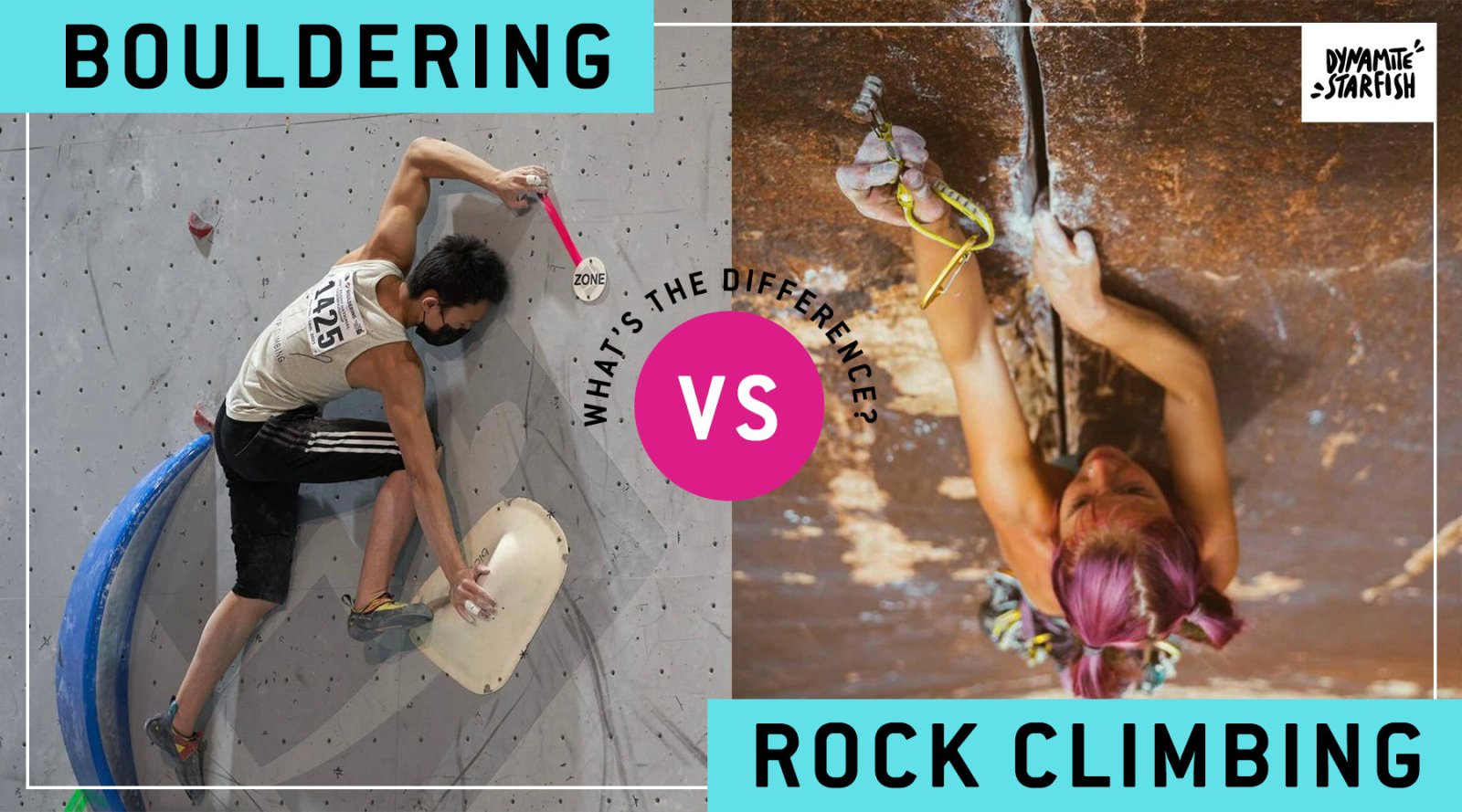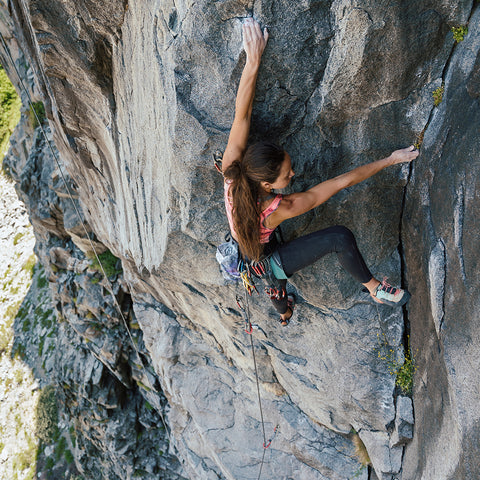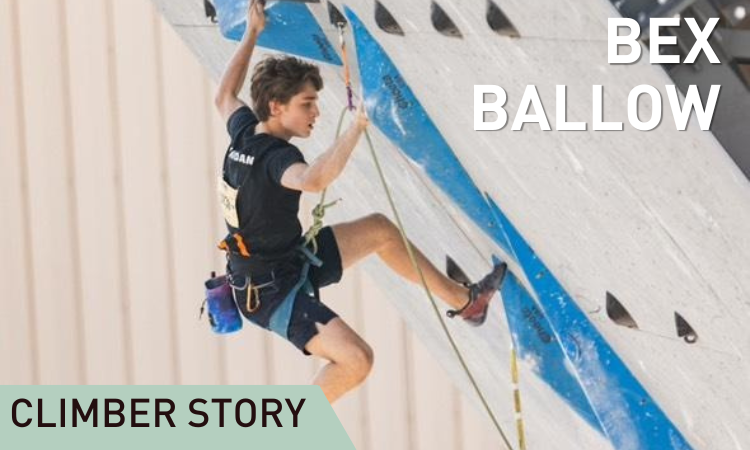Your Cart is Empty
DYNAMITE STARFISH'S ONLINE STORE IS CLOSED AS OF DEC 1, 2026. ask your local gear shop or climbing gym if they stock our products.
DYNAMITE STARFISH'S ONLINE STORE IS CLOSED AS OF DEC 1, 2026. ask your local gear shop or climbing gym if they stock our products.
Rock Climbing vs Bouldering: A Terminology Guide to Climbing Styles
July 30, 2022 6 min read

“What is the difference between rock climbing and bouldering?” We get this question so often we decided to write a little terminology guide to explain!
The quick answer — bouldering is rock climbing. It’s not a matter of one versus the other.
Rock climbing is a vast sport that contains many different disciplines within it. In this guide, we'll outline some of the most common types of climbing that you should know about before heading to the crag (or gym!)
(Title photos courtesy of Thomas Lin and Cierra Heiser)
Click on a term to read more about it, or just scroll down below!
Rock Climbing
Bouldering
Free Climbing
Solo Climbing
Sport Climbing
Trad Climbing
Aid Climbing
Single-pitch Climbing
Multi-pitch Climbing
Big Wall Climbing
Rock Climbing

(Michael Memmel & Alex Barlow climb El Capitan in Yosemite, California)
This is an umbrella term which includes all forms of rock climbing, both indoor and outdoor, on ropes or without. If you’re going out and scaling any kind of rock with your hands and feet, you are rock climbing!

(Erin mid-route on a trad climb, rock climbing outdoors)

(Thomas Lin rock climbing at an indoor bouldering competition)
Bouldering

(Photo by Joe Chun)
Bouldering is a more specific type of rock climbing where the climber is not tied in to any kind of rope. Instead of ropes and gear, boulderers use spotters and giant foam pads called crash pads placed on the ground to cushion their fall.
Climbs are referred to as boulder problems (or just problems for short) and typically range from 6 to 15 feet in height. Boulder problems taller than 15 feet are called high balls and should be approached with extreme caution. Bouldering also tends to be more physically demanding than other climbing styles due to the short length of each problem.

(Ravinder Singh bouldering above a crash pad in Joshua Tree, CA)

(Climber bouldering on a steep boulder. Photo by K Salazar)

(Groups of boulderers climbing in a popular bouldering area. Photo by @mithbear)
Free Climbing

(Photos courtesy of Erik Fallecker, Thomas Lin, and Khianna Cora Kuuleipoinaole DeGarmo)
Not to be confused with free SOLO-ing. Free climbing is another umbrella term that includes any type of climbing using only your body, climbing shoes, chalk, and natural rock surfaces to get yourself up the wall.
Protective gear can be used in free climbing (like ropes and quick draws), but specialized aid climbing gear is not used (like aid hooks and ladders). Free climbing is the type of climbing most commonly practiced today.

(Harrison Higgs bouldering, a form of free climbing)

(Ev Tram ties into a rock climbing rope, ready for some free climbing)
Aid Climbing 
(Rock climbing using an aid ladder. Photo c/o Alex Barlow)
Aid climbing is a form of climbing that involves specialized gear such as hooks, ladders, and jumar devices which are used to 'aid' your ascent up the wall. When you are aid climbing, you’re not relying solely on your body movement to do a climb, but also on your gear to get you from bottom to top.
Aid climbing was considered mainstream among the world of mountaineering in the early 1900s; however, the arrival of modern climbing gear in the 60s meant that many old aid routes can now be free climbed.
Solo Climbing

(Kelsey Greco deep water solo climbing)
Solo climbing essentially means climbing alone. Although you are technically soloing if you are bouldering alone, this practice is quite common among modern climbers and is not frequently called “soloing”. On the other hand, climbers can rope solo, which means they are belaying themselves by using some kind of auto-locking belay device.
Free soloing, made famous by Alex Honnold in the film, “Free Solo,” is perhaps the most well known type of soloing due to its media exposure. When free soloing, the climber climbs a route that is normally climbed with rope protection, but does so without using any protective gear. Free soloing, and all types of soloing, are generally high-risk activities that are not recommended for beginners and should always be approached with extra caution.

(Robert Chow takes a selfie while rope solo climbing)
Sport Climbing

(Ravinder Singh pulls through a steep sport climb)
Sport climbing is one of the most common and popular disciplines of rock climbing due to its accessibility. This style of climbing relies on the protection of ropes and fixed bolts. Bolts and anchors are drilled into the rock wall, and climbers only need to bring quick draws and their own rope to climb these routes.
The average sport route ranges between 50 and 100 feet with bolts placed anywhere from 5 to 10+ feet apart. Because sport routes have many moves over a long distance, you'll need to work on your endurance to avoid the dreaded forearm pump!

(photo of Tammy Watson sport climbing by Eric Fallecker)

(Kimberly Wendler with a drill and hammer, ready to install some sport climbing bolts)
Trad (traditional) Climbing

(Robert Chow trad climbing over a birds eye view)
Trad climbing, short for traditional climbing, is less pervasive than sport climbing due to its higher reliance of climbing gear. The main difference between these two climbing styles is that a a trad climber must bring their own protection to clip their rope to as they move up the wall wheras sport climbers use pre-placed bolts. Protective gear used for trad climbing can include cams, nuts, tricams, and hexes.
When trad climbing, the gear is generally placed into naturally forming cracks or other features in the rock and temporarily left in place. The leader places the gear and climbs to the top of the pitch, after which the follower removes the gear on their way to the top. After the climb, all protective gear is retrieved and can be used again for the next pitch or the next climb.

(A climber attempts to place gear into a crack. Photo by Greg Epperson)

(Ariel Santa Maria trad climbing in a wide crack)
Single-Pitch Climbing

(Photo by Caroline Reed)
If you think of a climbable rock like a building, a pitch, simply put, is one “story” of climbing. Just like a single-story building only goes up so high, a single pitch climb also has a maximum height due to the finite length of climbing ropes.
Most climbing rope lengths are anywhere from 50-70 meters, which is enough to climb and lower off most single pitch routes. Whether you're out for a day of trad or sport climbing with friends, chances are you will be single-pitch climbing.
Make sure to check the area in which you are climbing beforehand to make sure your rope is long enough!

(Climbers on a single pitch climb. Photo by Ev Tram)
Multi-Pitch Climbing

(@estheroutside multi-pitch trad climbing. Photo by Robert Shortt)
Multi-pitch climbs are comprised of a series of pitches, separated by anchors where the climbers set up belay stations to prepare for the next pitch. When one pitch has been climbed by both the leader and the follower, the climbers now have the full length of rope to use to get up the next pitch. Leaders and followers can switch roles at this point. Alpine climbs and any kind of climbing on very tall rock feature will involve multiple pitches.
There are multi-pitch sport routes, trad routes, aid routes, and routes that have a mixture of the three.
(When multi-pitch climbing, all parties climb pitch by pitch until they get to to the top. Photo: Alex Barlow)
Big Wall Climbing

(Life on a portaledge. Photo by Alex Barlow)
Big wall climbing is a type of multi-pitch climbing that involves… you guessed it… very big walls (think Yosemite). These climbs usually require a lot of gear and planning since walls this big often cannot be climbed in a single day.
Along with climbing gear, the climbers have to bring equipment that is used to sleep, cook, and essentially live on the wall for multiple days. Big wall climbing often involves some amount of aid climbing, but that is not always the case.
(Alex Barlow and Michael Memmel big wall climbing The Nose in Yosemite, CA)

(Gear for big wall climbing. Photo c/o Alex Barlow)
There are many forms of rock climbing, and most climbers focus on just a few climbing disciplines. But there's no need to choose right away, especially if you're a just starting out on your rock climbing adventure. Head to your local gym, start meeting other motivated climbers, and see what gets you stoked!
We hope this guide has been helpful to you in learning about rock climbing vs bouldering. Which climbing style are you most interested in? Let us know in the comments!
Happy climbing DS fam!
Leave a comment
Comments will be approved before showing up.
Also in News

The Climbing Training Struggles You Can’t Ignore (And How to Overcome Them)
March 19, 2025 6 min read
Read More
Building Trust and Teamwork: Qualities of a Great Climbing Partner
February 12, 2025 4 min read
Read More Recent Articles
- The Climbing Training Struggles You Can’t Ignore (And How to Overcome Them) March 19, 2025
- Building Trust and Teamwork: Qualities of a Great Climbing Partner February 12, 2025
- Climber Story: Bex Ballow January 29, 2025
- 9 Climbing Resolutions for 2025 December 31, 2024
- Climber Story: Kanani Kalahiki December 11, 2024
- 12 Awesome Gift Ideas for Climbers in 2024 November 20, 2024
- Climber Story: Nick Ranelli November 06, 2024
- If climbing was a scary movie, this would be the title... October 30, 2024
- Climber Story: Britney Berkstresser October 02, 2024
- The best (and worst) names for climbing routes we've ever seen September 25, 2024
Subscribe
Sign up to get the latest on sales, new releases and more …
want 15% off?
Get a welcome gift when you sign up with us!


